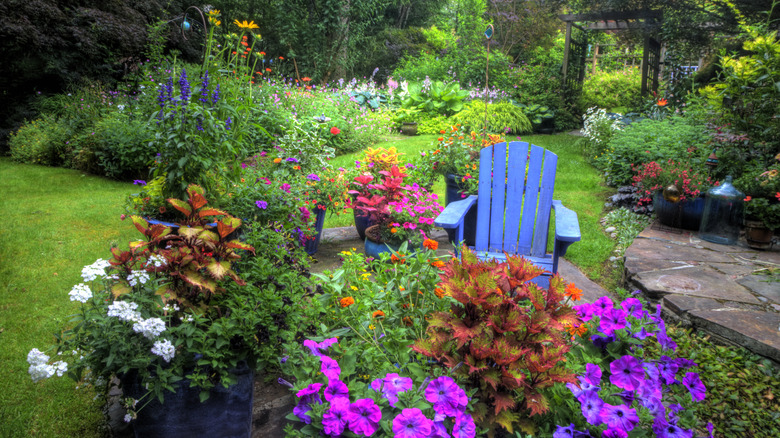Annual Vs Perennial Plants: What's The Difference And Which Should You Grow?
Even as a seasoned gardener, you may still have those head-scratching moments when you wonder to yourself, "Do annuals or perennials come back every year?" It happens to the best of us. The easy explanation is that annuals only pop up for one growing season (think, "anew") and perennials last many seasons (think, "persist"). But what's the real difference between the two and what are the best ones of each to grow?
The Encyclopedia Britannica says that an annual is "any plant that completes its life cycle in a single growing season." Annuals can be flowers, vegetables, or weeds. A perennial, on the other hand, is defined as "any plant that persists for several years." This includes not just flowers, but groundcovers, shrubs, and trees. The reason perennials can return after a cold winter is that they have underground root systems, stems, and bulbs that help them survive. While the plant may look dead above ground, it's actually in a deep state of dormancy that allows it to survive dehydration and freezing temperatures.
Despite the term "perennial," it's actually a misnomer on two counts. First, perennials simply don't last forever as their name implies. Depending on the climate, the type of plant, and your gardening skills, perennials can live anywhere from 10 to 60 years – or even longer in the case of trees. Secondly, some perennials are also annuals and vice versa. Say what? That's because some climates have mild enough winters (generally above 55 degrees Fahrenheit) that annuals can survive and rebloom the next spring. These are called tender perennials and include some varieties of begonias and geraniums, among others.
The most popular and longest blooming annuals and perennials
A popular school of thought among gardeners is that both annuals and perennials are worthy of growing. Granted, you will spend more time and money maintaining annuals in your garden rather than just sitting back and watching your perennials bounce back year after year. But because annuals are known for their showy blooms and vibrant colors, they're worth the effort.
Some of the most popular and reliably attractive annuals include familiar names like marigold, zinnia, cosmos, cornflower, sunflower, lobelia, and nasturtium. These varieties are popular not only for their beauty, but because they all grow in USDA hardiness zones 2 through 11 in container gardens or directly in the ground. Others you may be familiar with, such as pansies, snapdragons, and petunias, can't grow quite as far north. For the longest lasting blooms, try growing zinnias. These flowers come on in early summer and should continue to bloom until the first frost. To keep all of your annuals blooming as long as possible, you'll need to deadhead the flowers regularly.
For sun-loving perennials in your garden that can be grown reliably in zones 3 through 9 or even slightly farther south, there are dozens of options including daylily, bee balm, black-eyed susan, peonies, salvia (sage), catmint, delphinium, and penstemon. For shady areas, try columbine, hosta, violet, bleeding heart, or trillium. If you're looking for a really long-blooming perennial, black-eyed susan (Rudbeckia spp.) can bloom for up to 10 weeks, from mid-summer to early fall. Some perennials require cutting back or covering before winter, so heed the advice that comes with your starter plants or seeds.

